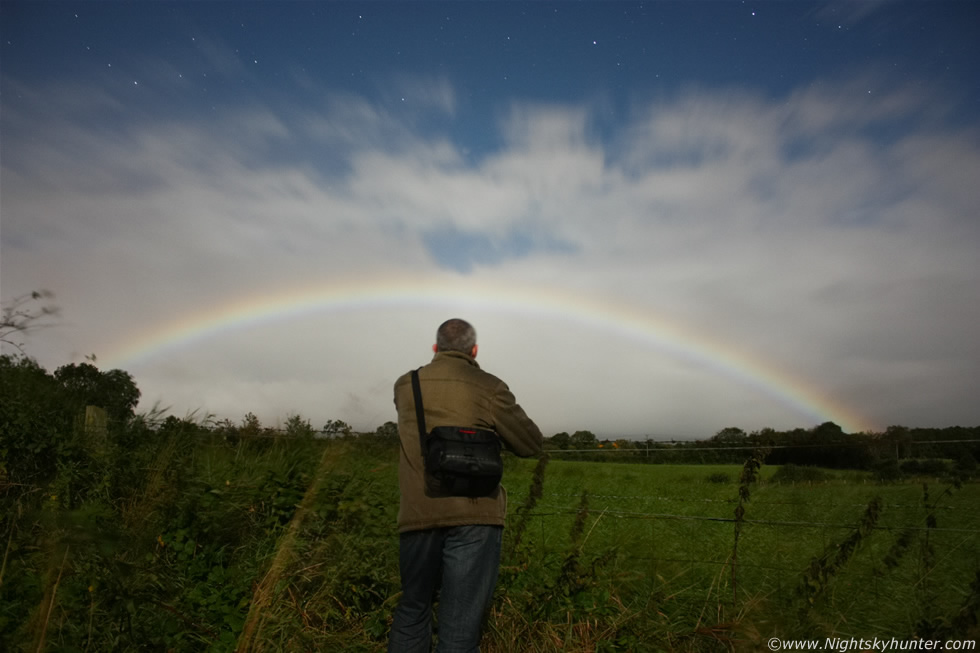

 |
 |
 |
(Above) A brilliant Moonbow captured over Maghera, N. Ireland during an unsettled night on Sept 13th 2012 - More
Have you ever seen a rainbow at night? If you haven’t then don’t feel left in the dark because many professional Astronomers and Meteorologists are unaware that such a phenomena even exists. A delicate marriage between specific astronomical and weather conditions are required for their formation, and just like their daytime cousins, ‘Lunar Rainbows’ or ‘Moonbows’ are produced very much in the same way.
When a beam of sunlight passes through a water droplet its light gets split into its component colours due to the droplet’s refractive properties. This produces the full range of colours or 'spectrum' with which we are all so familiar with. The genesis of the Moonbow is no different with the exception that the light source is replaced by the Moon itself. This is where our connection with the daylight bow ends, for to get the correct ingredients for a lunar version we need to accommodate several other criteria.
1) Although Moonbows can be seen anytime the Moon is conspicuous in the sky the best examples are witnessed when the Moon phase is bright. This means that the period around full Moon and the two days before and after when the gibbous phase is particularly brilliant are the favoured hunting window periods to catch them.
2) A dazzling Moon in the sky on its own will not produce a bow without water droplets in the atmosphere so rain is the next important ingredient. The enthusiastic Moonbow seeker should choose an unsettled night with good clear spells and periodic showers which often occur in the wake of a retreating cold front. Although water droplet size can also play a role in the quality of the bow, including the distance between the falling precipitation and observer, these come second place to the correlation between the Moon’s location in a clear sky with showers falling in the region opposite the Moon. It is this anti-lunar point where a bow will suddenly form, so by simply standing with your back to the Moon you will be looking in the correct area which will be directly in front of you.
3) Due to the particular atmospheric optical parameters of water droplets and light it pays to be outside at a time when the Moon is at a favourable height in the sky. If the Moon is greater than 42 degrees (84 apparent Moon diameters) above the horizon then no bow can form so a lower Moon altitude should be sought after. A low Moon elevation will generate a large bow, and high Moon elevation a small bow.
These are the basic conditions necessary for the formation of a Moonbow. However, getting these all together at the same time is exactly why sightings of this beautiful phenomena are so rare. A working knowledge of the monthly motion of the Moon combined with regular monitoring of weather data via online radar images should be employed by anyone who would like to observe more than one in a life time. Until recently Moonbows where mostly reported from certain places on Earth such as the Scottish Highlands and Hawaiian Islands. However, due to our wet climate N. Ireland (all of UK included) has now been proudly located on the map as a prime location for regular Moonbow formation.
Moonbows are extremely rare, but once seen are never forgotten. An apparition may by a fleeting affair lasting only seconds to minutes at a time however the experience is often potent enough to leave a lasting alien impression on the observer who was fortunate enough to have seen it. These bows are often described as ghostly or eerie due to their ‘out of place’ appearance at night. More often than not a Moonbow may look grey or white in colour when produced by feeble moonlight but under the correct conditions a brighter example can look breathtaking.
The very finest specimens can be seen when water droplets are blown down-wind ahead of the main body of a shower or convective cell. When this happens the Moonbow can be viewed against a clear sky background filled with bright stars. A truly prize event would exhibit a combination of intense Primary and Secondary arcs sporting vivid multiple colours, Alexander’s Dark Band bridging the gap between both bows, and Supernumerary Arcs. Fortunate is the person who is unexpectantly rewarded with such a phantom before their eyes on a still dark night.
The few sightings of Moonbows which do get reported are typically made when an observant individual spies the phenomena quite by accident during a late night walk or catches one in the act from his or her back door while performing some Earthly routine. Some photographers, including myself, take great pleasure in trying to catch these special transient visitors at all hours of the night as we endure the elements in a quest for that once in a life time image. If you are reading this and would like to see a Moonbow of your own then why leave things to chance? The information above will tell you when and where to look if you stay vigilant. Your chances are good, after all N. Ireland is the place to be!. * This article is a copy of a piece I wrote for a local N. Ireland newspaper.
Martin McKenna